
Rome is the capital of Italy and the country's largest and most populated municipality (central area), with over 2.7 million residents in 1,285.3 km2 (496.3 sq mi), while the population of the urban area is estimated by Eurostat to be 3.46 million. The metropolitan area of Rome is estimated by OECD to have a population of 3.7 million. It is located in the central-western portion of the Italian Peninsula, on the Tiber river. The city has been one of history's most powerful and important centres, being the home of the emperor during the Roman Empire and the Italian government. The city also has a significant place in Christianity and is the present day home of the Roman Catholic Church and the site of the Vatican City, an independent city-state run by the Catholic Church. Due to this, the city has often been nicknamed "Caput Mundi" (Latin for "Capital of the World") and "The Eternal City". Also, Rome is widely regarded as one of the world's most beautiful ancient cities
The Colosseum
The Colosseum is probably the most impressive building of the Roman empire. Originally known as the Flavian Amphitheater, it was the largest building of the era.
The monumental structure has fallen into ruins, but even today it is an imposing and beautiful sight.
The elliptical building is immense, measuring 188m by 156m and reaching a height of more than 48 meter (159 ft). The Colosseum could accommodate some 55,000 spectators who could enter the building through no less than 80 entrances.
Above the ground are four storeys, the upper storey contained seating for lower classes and women. The lowest storey was preserved for prominent citizens. Below the ground were rooms with mechanical devices and cages containing wild animals. The cages could be hoisted, enabling the animals to appear in the middle of the arena.
Inauguration
Hundred-day games were held by Titus, Vespasian's successor, to mark the inauguration of the building in AD 80. In the process, some 9,000 wild animals were slaughtered.
The Ruins
The southern side of the Colosseum was felled by an earthquake in 847. Parts of the building - including the marble facade - were used for the construction of later monuments, including the St. Peter's Basilica.
St. Peter's Basilica
This great building is the center of christianity. The opulence of the building's interior bears testimony to the wealth of the catholic church in the 16th century.

Emperor Constantine, the first Christian emperor of Rome, ordered to build a basilica on Vatican Hill. The location was symbolic: this was the place where Saint Peter, the chief apostle, was buried in 64 A.D. A small shrine already existed on the site but it was now replaced by a new building church was completed around 349 A.D.
A New Basilica
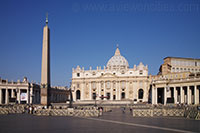
St. Peter's Square
In the middle of the 15th century, the basilica was falling into ruin and pope Nicolas V ordered the restoration and enlargement of the church after plans by Bernardo Rossellino. After Nicolas V died, works were halted. In 1506 pope Julius II laid the first stone of a new basilica which was to become the largest in the world.
Julius II appointed Donato Bramante as the chief architect of the new Basilica. In 1547 Michelangelo succeeded Bramante. He designed the imposing dome and altered some of the original plans.
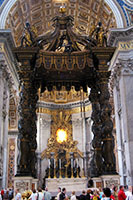
Bernini's Canopy
Michelangelo died in 1624, two years before the St. Peter's basilica was dedicated by pope Urban VIII. Ever since, this church has been the center of Christianity, drawing pilgrims from all over the world.
The Building
The building itself is truly impressive. The largest church in the world, it has a 218 meter long nave. The basilica's dome is the world's largest measuring 42m in diameter and reaching 138 meter high (more than 450ft). The interior, which includes 45 altars, is decorated by
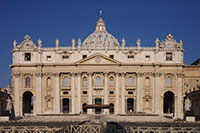
St. Peter's Basilica
many famous artists. Some of the most important works in the church are the Pietà by Michelangelo, the papal altar by Bernini, the Throne of St. Peter - also by Bernini - and the Monument to the Stuarts by Canova.
The opulent interior can be visited daily for free although a strict dress code is enforced.
Dome observatory
You can also visit the dome itself (entrance is not free, but it's worth it). You have the option of taking the elevator or the stairs, the latter being a bit cheaper.
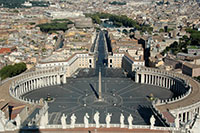
The Piazza seen from the church's dome
The elevator brings you to the bottom of the dome from where a small, long and mostly spiral staircase brings you to the top of the dome. From there you have a magnificent view of Rome and of the Saint Peter's square in particular. The famous square with long symmetrical colonnades was designed by Bernini. It features a central obelisk and two identical fountains.
The Swiss Guards
Near the entrance of the Basilica you will probably encounter some of the famous Swiss guards.
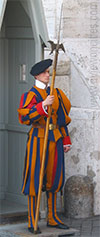
Swiss Guard
Since 1506 when pope Julius II invited Helvetian soldiers to join the small Vatican army, they have been the guards of the Vatican and the pope in particular. All entrants to the army must be Swiss, catholic and they must take the oath of loyalty to the pope. This oath is taken May 26th, to commemorate the sacking of Rome on the same day in 1527 when Swiss guards protected pope Clement VII during his escape to the Castel Sant'Angelo. Of the 189 guards, only 42 survived.
Location
St. Peter's is located in Vatican City, across the river Tiber, west of Rome's center. Vatican City is completely surrounded by the city of Rome.
The Fontana di Trevi
The Fontana di Trevi or Trevi Fountain is the most famous and arguably the most beautiful fountain in all of Rome. This impressive monument dominates the small Trevi square located in the Quirinale district.

Aqua Virgo
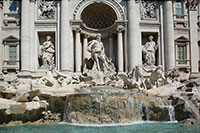
The Trevi fountain is at the ending part of the Aqua Virgo, an aqueduct constructed in 19 BC. It brings water all the way from the Salone Springs (approx 20km from Rome) and supplies the fountains in the historic center of Rome with water.
Construction of the Fountain
In 1732, Pope Clement XII commissioned Nicola Salvi to create a large fountain at the Trevi Square. A previous undertaking to build the fountain after a design by Bernini was halted a century earlier after the death of Pope Urban VIII. Salvi based his theatrical
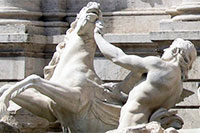
The restive sea horse
masterpiece on this design. Construction of the monumental baroque fountain was finally completed in 1762.
The Fountain
The central figure of the fountain, in front of a large niche, is Neptune, god of the sea. He is riding a chariot in the shape of a shell, pulled by two sea horses. Each sea horse is guided by a Triton. One of the horses is calm and obedient, the other one restive. They symbolize the fluctuating moods of the sea.
On the left hand side of Neptune is a statue representing Abundance, the statue
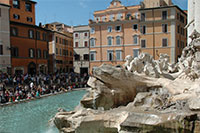
The crowded square
on the right represents Salubrity. Above the sculptures are bas-reliefs, one of them shows Agrippa, the general after whom the aqueduct was named.
Tossing a Coin
The water at the bottom of the fountain represents the sea. Legend has it you will return to Rome if you throw a coin into the water. You should toss it over your shoulder with your back to the fountain.
The Forum Romanum
The Forum Romanum was the center of life in imperial Rome, evidenced by the many remains of triumphal arches, temples and basilicas.
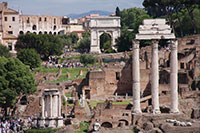
Forum Romanum seen from Capitol
History
Until 509 BC, when Rome became a republic, the city was reigned by an Etruscan dynasty of Tarquin Kings. They built a sewer, the 'Cloaca Maxima', to drain water from the marshlands of the valley between the Palatine, Capitol and Esquiline hills to the Tiber river. Ever since, the area was the center of activity in Rome.
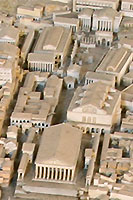
The Forum in better days
It was the site of the first forum. Here, triumphal processions took place, elections were held and the Senate assembled.
The Forum Romanum Today
Today, the forum known as the Forum Romanum can look like a disorderly collection of ruins to the uninitiated, but with some imagination you can see the Roman empire come back to life at this site. Remains of many buildings from different periods are visible; the forum was littered with temples, basilicas and triumphal arches.
Triumphal Arches
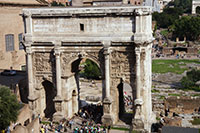
Arch of Septimius Severus
Three triumphal arches were built on the forum. They were used by emperors to commemorate their victories.
Hardly any remains are left from the first one, constructed by Augustus in 29 BC.
The Arch of Titus, built in AD 81 commemorates the victory in the Jewish War. It is located at the Via Sacra on the eastern side of the forum.
At the other end of the forum, near the capitoline hill is the Arch of Septimius Severus. It was built in AD 203 to commemorate the victory over the Parthians.
Curia Julia
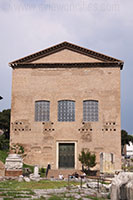
Curia
The Curia was the location where the senate assembled. The rectangular brick building could seat up to 200 senators.
The original Curia was built by the third king of Rome (although at another location). It burnt down four times, first in 80 BC but it was rebuilt each time. After a fire in 53 BC Caesar moved the Curia to the Forum Romanum. The current building was constructed in AD 283 by Diocletius. In the 7th century the Curia was turned into a church, but fortunately the building was mostly kept intact.
Rostra
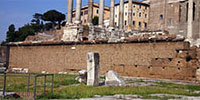
Rostra
The Rostra was a speaker's platform, originally built in the 4th century BC at a nearby location. The name Rostra, which means 'battering rams', was derived from the iron-clad battering rams of Volscian war vessels captured at the battle of Antium in 338 BC. The platform was decorated with many of those battering rams.
As part of his modifications of the Forum, Caesar built the Rostra at its present location, this time in marble.
Thanks to Spakespeare's version, the most famous speech at the Rostra was given in 44 BC by Marcus Antonius when he addressed the crowd during Julius Caesar's funeral "Friends, Romans, countrymen, lend me your ears...".
Temple of Saturn
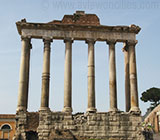
Temple of Saturn
The first Temple of Saturn was built during the last years of the Etruscan kingdom. It was inaugurated at the beginning of the republic in 497 BC. The current ruins date from 42 BC. The temple was used as the state treasury (Aerarium). It also housed the banners of the legions and the senatorial decrees. In 20 BC a tall column, the Miliarum Aureum, was placed in front of the temple by emperor Augustus.
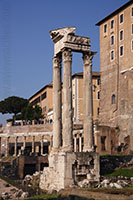
Temple of Vespasian
Temple of Vespasian and Titus
Construction of this temple was started in the 1st century AD by Titus in honor of his deified father Vespasian.
Emperor Domitian, Titus's brother and successor, completed the structure, now dedicated to both Titus and Vespasian. The temple had a hexagonal plan with a large cella (sanctuary) with statues of the two emperors.
Temple of Castor and Pollux
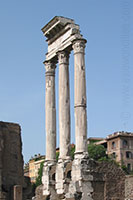
Temple of Castor & Pollux
Only three pillars remain of the Temple of Castor and Pollux. The original temple was built in 484 BC, the current ruins date from its last reconstruction in 6 A.D. The temple was built by the roman dictator Postumius who vowed to build the temple if his army would beat the Tarquin Kings who previously ruled Rome. According to the legend, Castor and Pollux, mythological twin brothers, helped the Roman army to victory and announced the victory at the forum.
Temple of Antoninus and Faustina
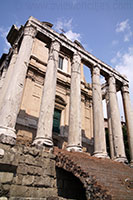
Temple of Antoninus and Faustina
The Temple of Antoninus and Faustina was built in 141 AD by emperor Antoninus Pius to honor his deceased wife Faustina. After the death of the emperor twenty years later the temple was rededicated to both Antoninus and Faustina. In the 7th century the temple was converted into the church of San Lorenzo in Miranda. The church was rebuilt in 1601.
The deep grooves in the marble columns are attributed to attempts to tear down the columns. The cords burnt into the columns, but fortunately they did not budge.
Basilica Julia
In 54 BC Julius Caesar started construction of the Basilica Julia,
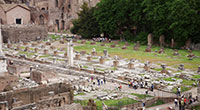
Basilica Julia
a building used as the seat of the centumviri, a court of civil jurisdiction where magistrates held tribunals. The large building, 101m long and 49m wide, was destroyed by fire in 9 BC but rebuilt again seven years later. After the fall of Rome the basilica was sacked. Not much remains of it today but you can still clearly see the floor plan.
Basilica Aemilia
The Basilica Aemilia is the oldest basilica at the forum,
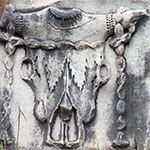
Detail of Basilica Aemilia
originally built in 179 BC by consuls Marcus Aemilius Lepidus and Marcus Fulvius Nobilor. The purpose of the basilica was to provide a sheltering place so that many of the businesses and administration that normally took place outside could be carried out in case of bad weather. It was last modified in 22 AD; at that time the great marble hall with four aisles incorporated a number of public shops (tabernae).
The Basilica was destroyed by a fire during the sack of Rome by the Visigoths in 410 AD.
Temple of Vesta
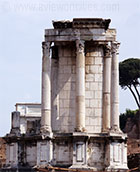
Temple of Vesta
The circular temple of Vesta dates back to the 4th century BC. The small temple was one of Rome's most important as it was dedicated to the protectress of both the family and State. Here the Vestal Virgins guarded the sacred eternal flame, symbol of the eternal life of Rome. The Virgins guarding the flame were chosen by the Pontifex Maximus, the supreme religious authority of the State. The girls, who had to be aristocrates, had to serve for 30 years.
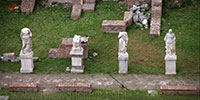
Statues of Vestal Virgins
During that time they had to stay virgins, otherwise they would be buried alive (this happened to 10 of them). The Vestal Virgins were highly regarded and enjoyed many perks.
House of the Vestal Virgins
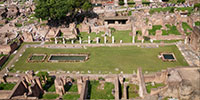
House of the Vestal Virgins
Right near the Temple of Vesta stood the House of the Vestal Virgins. As soon as a girl was chosen as a Vestal Virgin (at the age of 6), she would move here. The large house featured 50 rooms for the six girls and their servants, spread over three floors. The rooms opened onto galleries surrounding a courtyard.
Temple of Divus Romulus
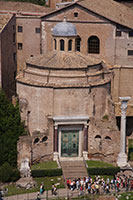
Temple of Romulus
Opposite the House of the Vestal Virgins is the circular Temple of Romulus, built in the 4th century AD. The building is mostly intact due to its incorporation into the church Santi Cosma e Damiano. The large well-preserved bronze door is original. There is still a debate going on as to who this temple was dedicated to. For now it is assumed that this temple was dedicated to the son of Maxentius, who died young in 307 BC.
Basilica of Maxentius
Construction of the last of the large basilicas was started by emperor Maxentius in 308 AD.
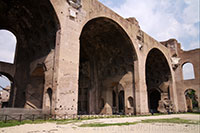
Basilica of Maxentius
After his defeat by Constantine during the famous battle at the Milvian Bridge in 312 AD, the basilica was completed by Constantine.
The basilica measured 100m by 65m and was an impressive 35m high. It consisted of a large central nave with enormous corinthean columns and two smaller aisles. One column was moved in 1614 to the square of Santa Maria Maggiore. A 12m high statue of Constantine, partly in marble and partly in wood, occupied the western end of the Basilica. Parts of the statue can now be found at the courtyard of the Palazzo dei Conservatori, part of the Capitoline Museums.
Temple of Venus and Rome
Ancient Rome's largest religious structure was built at the end of the
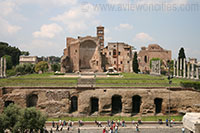
Temple of Venus and Rome
Forum Romanum, near the Colosseum. Designed by emperor Hadrianus in 135 AD, this temple measured an impressive 100m by 145m. The temple was dedicated to Roma, the personification of the city and Venus, mother of Aeneas (assumed father of Remus and Romulus). The building contained two cella's (sanctuary) with statues of the goddesses, each located at one side of the temple. Part of the cella dedicated to Roma is still standing today.
Column of Phocas
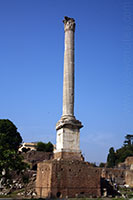
Column of Phocas
This 13.5m high column is the youngest of the forum. It wasn't part of any temple, but it is a monument built in 608 AD in honor of the Byzantine emperor Phocas, who had just visited Rome.
More remains
Remains of several more structures can be found at the Forum Romanum, among them the Sacellum of Venus Cloacina, the Porticus Deorum Consentium, the arch of Actium, the Regia, the Temple of Divus Julius - built by Augustus in honor of Julius Caesar - and the Temple of Concord.
The piazza di Spagna
The piazza di Spagna is one of the most popular meeting places in Rome. It is also one of the most visually pleasing squares. The combination of a monumental staircase - the famous Spanish Steps, an obelisk and a beautiful church draws photographers to the square.
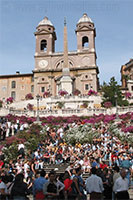
Spanish Steps
The Piazza di Spagna or Spanish Square is connected to a French church (Trinità dei Monti) on top of the hill via a long staircase, known as the Scalinata della Trinità dei Monti or Spanish Steps. The idea of connecting the church with the square below originates from the 17th century, when the French also planned a statue of King Louis XIV of France at the top of the staircase.
Papal opposition caused the plans to be shelved until 1723, when the monumental staircase was built without the statue. Pope Innocent XIII appointed the Italian architect Francisco de Sanctis. He presented a design that satisfied both the French and the papacy.
The elegant staircase consists of 137 steps over twelve different flights.
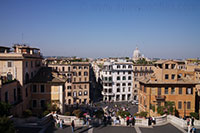
View from Spanish Steps
It has an irregular albeit symmetric structure. It is especially beautiful in May, when it is decorated with azaleas. The steps are usually very crowded; it attracts tourists as well as locals who use it as a gathering place.
Piazza di Spagna
At the bottom of the Spanish Steps is the Piazza di Spagna or Spanish square. The long, triangular square is named after the Spanish Embassy to the Holy See. In the 17th century, the area around the embassy was even considered Spanish territory.

It can get crowded on the steps...
Fontana della Barcaccia
At the foot of the Spanish Steps is the Fontana della Barcaccia,
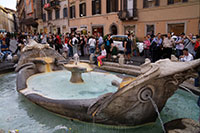
Fontana della Barcaccia
a sober fountain commissioned by Pope Urban VIII and designed by Gian Lorenzo Bernini. The design, a small boat, was inspired by the flooding of the Tevere in 1598, when a small boat stranded here after the water subsided.
Trinità dei Monti
The Trinità dei Monti is a beautiful French church located on a hill overlooking the small piazza della Trinità dei Monti. From this square, you have an nice view over Rome.
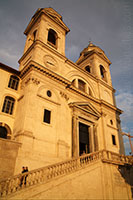
Trinità dei Monti
At the end of the 15th century, only a small chapel existed on the hill. In 1495, French King Louis XII commissioned the erection of a new church, replacing the chapel. Construction started in 1502 and dragged on for decades. It was only consecrated in 1585 by Pope Sixtus V.
The gothic church with a renaissance facade has two bell-towers. Inside, several paintings decorate the different chapels. Among them are two works by Daniele da Volterra, a pupil of Michelangelo.
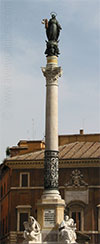
Colonna dell'Immacolata
Its location on top of the Spanish Steps make the Trinità dei Monti a well-known landmark in Rome.
The obelisk just in front of the church was originally located in the Gardens of Sallust. In 1788 it was moved to its current location on request of pope Pius VI. The hieroglyphs were copied from the obelisk on the Piazza del Popolo.
Colonna dell'Immacolata
In the southeast part of the square is the Colonna dell'Immacolata (column of the Immaculate conception). It was erected in 1857 to commemorate the dogma of the immaculate conception. The column was found in 1777 under a monastery. It is now topped with a statue of Virgin Mary.
Ara Pacis
Built to honor the Roman goddess of peace, the Ara Pacis is a stunning example of early Roman sculpture. The altar symbolized the establishment of peace in the Empire.
History of the Altar
Originally named the Ara Pacis Augustae but usually shortened to just Ara Pacis, the Altar of Majestic Peace was consecrated in 9 BC.
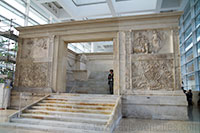
Ara Pacis
It was commissioned by Roman Emperor Augustus to celebrate his victories at Gaul and Hispania (now France and Spain) and the establishment of peace in the Roman Empire. At its time, it was considered one of the most important monuments in Rome.
It is said that the altar represents the peace and prosperity achieved as a result of the time period known as the Pax Romana, which occurred between the years 27 BC to 180 AD. The altar was originally located on the Campus Martius, in the flood plain of the Tiber River. It was placed in such a way that the shadow of the obelisk on the Campus Martius (now on the Piazza di Montecitorio) would fall on the Ara Pacis on the birthday of emperor Augustus
Arch of Constantine
Right next to the Colosseum stands the Arch of Constantine, the most recent of the three remaining imperial arches in Rome (the other ones are the nearby Arch of Titus and Arch of Septimius Severus). The 21 meter high arch is well preserved and richly decorated.
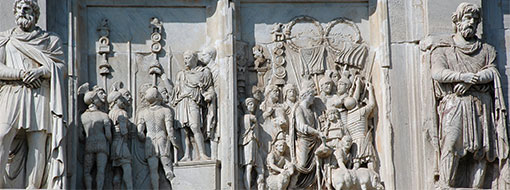
The Arch
The large arch with 3 archways is almost 26m (85ft) wide and 21m (69ft) high. During construction, many parts from older structures were reused, which was common practice at the time.
The statues at the top were Arch of Constantine, Rome taken from the Forum of Trajan. They
depict Dacian captured soldiers, defeated by the Trajan army.
The reliefs between the statues were created for Marcus Aurelius while the roundrels (and possibly even the arch itself) are from emperor Hadrian's time. Some figures in the roundrels were modified to resemble Constantine. The decorations at the central and lower part were created specifically for this triumphal arch.
The arch of Septimius Severus
The arch of Septimius Severus is one of the two remaining triumphal arches on the Forum Romanum, the other being the better known Arch of Titus.
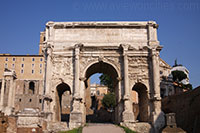
Arch of Septimius Severus
The Arch
The triumphal arch was built in 203 A.D. to commemorate the victories of emperor Septimius Severus in Parthia (now partly Iran and Iraq).
The arch is 23m high and 25m wide. It has three archways: the central one is 12m high and the others 7m 80cm. Originally a flight of stairs led to the central archway. It was only replaced by a road in the 4th century.
Location
The arch of Septimius Severus is located at the western end of the Forum, near the capitoline hill.
The Arch of Titus
The Arch of Titus is one of two remaining arches on the Forum Romanum. It was built to commemorate the capture of Jerusalem over the Jewish Zealots.
Jewish Revolt
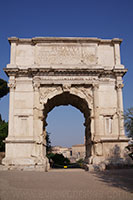
Arch of Titus
In AD 66 Jewish Zealots started a revolt against the Roman occupation of Judea. Vespasian was sent from Rome to crush the revolt. After Vespasian became emperor, his son Titus took over.
Titus captured Jerusalem in AD 70 with four legions and the revolt was completely crushed after the fall of the Masada fortress in AD 72.
Emperor Titus
In AD 79 Titus became emperor of the Roman empire. He died just two years later, in September AD 81. The popular emperor was soon deified by the Roman Senate. His son, emperor Domitian built the Arch of Titus that same year both to honor his brother and to commemorate the victory in the Jewish War. The arch was dedicated in AD 85 with large festivities.
Area Sacra dell'Argentina
Inadvertently unearthed during an excavation project ordered by Benito Mussolini, the fascinating Area Sacra dell’Argentina is one of the best sites to see the remains of Roman architecture from the Republican era.
Discovering the Site
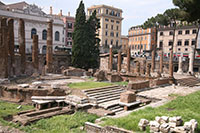
Area Sacra dell'Argentina
A project meant to demolish one of Rome’s old quarters resulted in one of the finest archaeological finds of the 20th century. In 1926, during demolition work for construction of a new building, workers began to discover the remains of four distinctly different temples, all located around a public square. The discoveries thrilled the archaeological community.
Column of Marcus Aurelius
After some unsophisticated excavations in the late 1920s and more complete investigations in later years, what emerged was some of the best examples of Republican Roman architecture. For years, little was known about the site and the newly-located temples were merely named by the letters of the alphabet. Today, a bit more is known about each of the structures.
The Column of Marcus Aurelius was built between AD 180 and AD 196 as a gift by the Senate and the people of Rome and erected near the emperor's own temple, the Temple of the Deified Marcus.
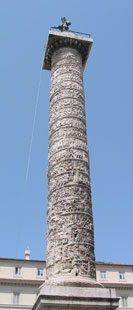
Aurelian Column
Military Campaigns
The monument - also known as the Aurelian Column - commemorates emperor Marcus Aurelius' military campaigns against Germanic tribes and the Sarmatians.
It is modeled on Trajan's Column, built 80 years earlier after emperor Trajan's successful campaign in Dacia.
The Aurelian Column
The Aurelian Column is some 30 meter high (100 Roman feet) and formed of 28 blocks of carrara marble. It is put on a large rectangular pedestal and bears a spiraling band of reliefs depicting events during the imperial campaigns in the north. The lower part shows the campaign against the Germanic tribes between
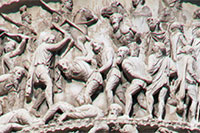
Detail of the Relief
169 and 173 AD and the upper part shows the campaign against the Sarmatians between 174 and 176 AD.
The reliefs are deeper and more expressive than those on the column of Trajan, but they are also less refined and the compositions have a lower quality. Inside the column, which has a diameter of 3,7 meter , is a spiraling staircase that leads to a platform at the top on which a statue of Marcus Aurelius and his wife Faustina the younger used to stand. This statue was
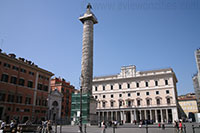
Piazza Colonna
replaced by a statue of st. Paul, the original has disappeared.
Piazza Colonna
There are no traces left of the nearby Temple of the Deified Marcus, but the Column of Marcus Aurelius still stands at its original location. It is now at the center of a small rectangular square, the Piazza Colonna, named after the column. The square is bordered by the Via del Corso on one side and palazzos on the other sides. Between the column and the Via del Corso is a small fountain built in 1575 by Giacomo Della Porta.
Aurelian Wall
Built to prevent attacks on the city of Rome, the Aurelian Wall incorporates a number of historic buildings.
Building a Wall
After nearly five centuries of unopposed domination, Emperor Aurelian of Rome (270-275 AD) recognized the threat from Germanic tribes near the borders of the Roman Empire, and he decided it was time to build a wall to protect the city. The city had long outgrown its old Republican Wall, which was built in the 3rd century BC. Until the 3rd century AD, Rome's power was so strong that the city did not feel the need for a protective wall.
The Aurelian Wall was 19 kilometer long (12 mile) and about 6 meter
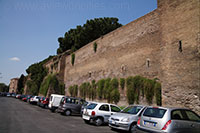
high (20 feet) 3.5 meters thick (11.5 feet). The wall included a square tower about every 30m (about 100 feet). It also featured many grand gates including the Porta Latina and Porta San Sebastiano which were covered by arches and protected by semi-circular towers.
Just a quarter of a century later, Emperor Maxentius found it necessary to further enforce the wall, and by the early 5th century, Emperor Honorius doubled its height and raised and strengthened its towers.
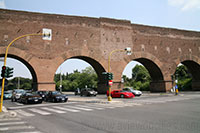
Byzantine general Belisarius made yet more improvements during the 6th century.
The wall continued to defend the city until 1870, when the Bersaglieri of the Kingdom of Italy breached the fortress near the Porta Pia and
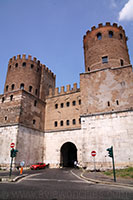
Porta San Sebastiano
captured Rome.
Remnants of the Wall
The uniqueness of the Aurelian Wall includes the fact that several buildings are incorporated into the structure. This was done to save time and allow the wall to be built at a lower cost.
Existing buildings included within the wall include Castel Sant'Angelo, originally Hadrian's Mausoleum; Amphitheatrum Castrense, a 2nd century Roman amphitheater built of brick; the Pyramid of Cestius, an Egyptian-style pyramid built in 12 BC as a tomb for Caius Cestius, a member of one of the four great religious corporations of early Rome;
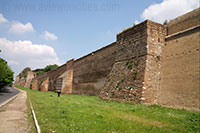
and a section of the Aqua Claudia aqueduct, which was built to supply several of the Roman districts with water.
Today, about two-thirds of the Aurelian Wall remains intact and quite well preserved. Visitors can head to the Museo delle Mura, near the San Sebastian gate, to learn more about the history of the wall and what they’ll find on a tour of the structure.
The Baths of Caracalla
The Baths of Caracalla were the largest thermae in the world when completed in 217AD. The were functional for over 300 years.
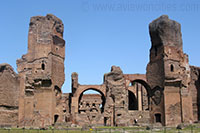
Baths of Caracalla
The red-brick ruins of the Baths of Caracalla are situated southeast of ancient Rome's center. This huge 27 acre complex (11 hectares) housed bathing facilities with seats for more than 1600 people. At a time when Rome's crowded tenements had few sanitary facilities, the more than 50 baths in Imperial Rome played an important part in the lives of the Roman citizens.
The ritual of bathing was a long process, starting with a hot bath in the calidarium. Next up was the lukewarm tepidarium, followed by the cold frigidarium. Then followed a
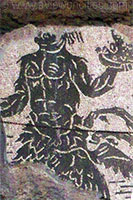
Mosaic decoration
swim in the natatio, an open air swimming pool.
Leisure Center
The complex was actually a multifunctional leisure center and also housed gymnasiums, libraries, gardens, art galleries, restaurants and even brothels. The Baths of Caracalla were known for its rich interior which featured marble seats, mosaic covered walls and floors as well as fountains and statues.
Construction
Construction of the Baths of Caracalla started in 212AD and was completed in 217AD.
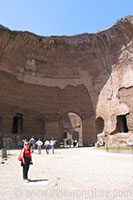
The complex was built during the reign of emperor Caracalla whose official name was Marcus Aurelius Antoninus, hence the original name of the baths, Thermae Antoninianae. The emperor was nicknamed Caracalla after a Gallic tunic he used to wear, but this name was never officially used.
Caracalla
Caracalla is infamous for killing his more popular brother Geta. He is also known for his decision to offer citizenship to all free inhabitants of the Roman Empire, mainly to increase the income from taxes.
Water Distribution
The baths were enormous buildings, with huge frescoed vaults covering the large rooms. A complex water distribution system ensured a
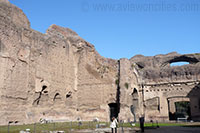
constant flow of water from the Aqua Marcia aqueduct.
Below the main buildings were two levels, the upper one was used for services and heating the water, the lower one was used for water drainage. The baths were fully functional until 537AD when Goths destroyed the aqueduct, cutting off the water supply.
Decay
Neglection, looting and an earthquake turned this great architectural complex into ruins. But even these ruins impress visitors by its magnificence.
The Capitoline Hill
The Capitoline Hill or Campidoglio is the smallest of Rome's seven hills, but it was the religious and political center of the city since its foundation more than 2500 years ago.
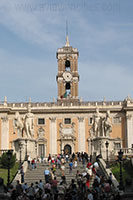
Capitoline Hill
Capitoline Hill
Several important temples were built at the Capitoline Hill by the Romans: the Temple of Juno Moneta, the Temple of Virtus and the Temple of Jupiter Optimus Maximus Capitolinus, the most important temple in ancient Rome.
The latter was built in 509 BC and was almost as large as the Parthenon in Athens.
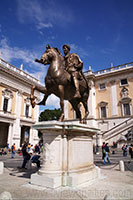
Statue of Marcus Aurelius
Also on the hill was the Tabularium, built in 79 BC and used as the empire's main archive.
The hill, and the temple of Jupiter in particular were the symbols of Rome as Caput Mundi, capital of the world.
Middle Ages
During the middle ages, the site became the center of civic government and several palaces were built on the hill. But when Charles V planned a visit to Rome in 1536, the muddy Capitoline Hill was in such a bad shape that Pope Paul III Farnese asked Michelangelo to design a new square, the Piazza del Campidoglio, including a redesign of the existing
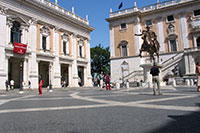
Piazza del Campidoglio
buildings surrounding the square.
Michelangelo's Design
Michelangelo came up with an original design for the square, including an intriguing ground pattern. He redesigned the Palazzo Senatorio, seat of the Roman senate. Michelangelo also made designs of a new façade for the Palazzo dei Conservatori and designed a new building, the Palazzo Nuovo, to be built just opposite the Palazzo dei
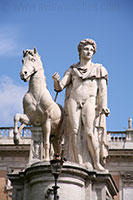
One of the Dioscuri
Conservatori. Also in the plans were a monumental staircase, the Cordonata, leading from the bottom of the hill to the new square. Construction of the Piazza di Campidoglio started in 1546 but only the staircase at the entrance of the Palazzo Senatorio was completed when Michelangelo died in 1564. The project was only finished in the 17th century, but most of Michelangelo's designs were implemented.
Cordonata
The long, beautiful staircase to the Piazza del Campidoglio is known as the Cordonata. It is adorned with granite statues of Egyptian lions at the foot and two large classical statues of Castor and Pollux at the top.
At the center of the square is a replica of a statue of
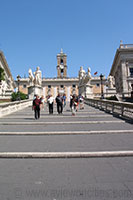
Cordonata
Marcus Aurelius. The original statue can be found in the Palazzo Nuovo.
Palazzo Nuovo
Only three buildings border the square. The one on the left coming from the Cordonata is the Palazzo Nuovo. The building was designed by Michelangelo, but finished by the brothers Carlo and Girolamo Rainaldi in 1654. In 1734, pope Clemens XII made the collection open to the public, creating the world's first public museum. Now one of the Capitoline Museums, it contains mostly classical sculpture including the 'Dying Gaul' and large statues of Minerva and Mars.
Palazzo Senatorio
The central building on the Piazza del Campidoglio is the Palazzo Senatorio. The name is derived from its function as seat of the Senate until 1870 when it became the
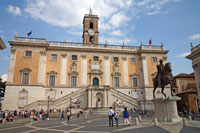
Palazzo Senatorio
seat of the City of Rome. It was originally built as a fortress in the 11th century on top of the ancient Tabularium and rebuilt again in the 13th and 14th century. The current design is a slightly adapted version of the 16th century design by Michelangelo.
Palazzo dei Conservatori
The building opposite the Palazzo Nuovo is the Palazzo dei Conservatori. It was the seat of the city government during the Middle Ages. The palazzo is now part of the Capitoline Museums, with a collection mainly consisting of sculpture and paintings. Some notable works are the
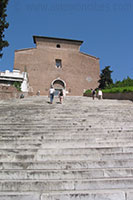
Ara Coeli
she-wolf suckling the twins Remus and Romulus and the pieces of a giant statue of emperor Constantine II.
Santa Maria in Aracoeli
Near the Piazza del Campidoglio, at the site of the ancient temple of Juno is the Santa Maria in Aracoeli, a church which origins go back to the 6th century. A large staircase, 122 (when starting on the right) to 124 (starting on the left) steps lead to the church on top of the Capitoline Hill.Victor Emmanuel Monument
There is also a connection from the Piazza del Campidoglio to the monument Victor Emmanuel II. That will save you a climb on yet another large staircase.
Capitoline Museums
Established in the late 15th century, Rome’s Capitoline Museums provide an impressive look at Roman art and archaeology.
Overview
Situated at the Campidoglio square on top of the Capitoline Hill – thus their name –
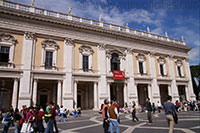
Palazzo Nuovo
the Capitoline Museums are a must-see for visitors who are entranced by ancient Roman history and welcome the chance to view some of the city’s best treasures.
The museums, housed in two palaces, are situated around a central square – or piazza – designed by Michelangelo Buonarroti in 1536 and completed over a period of more than 400 years. The museums are connected via an underground tunnel, which also leads to the ancient Tabularium.
The origins of the museums can be traced a little further back – to 1471 – when
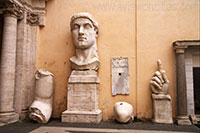
Parts of the Statue of Constantine II
Pope Sixtus IV donated his impressive collection of ancient bronzes to the city for public viewing. He placed them in a structure atop Capitoline Hill. The museums are now owned by the city.
Campo dei Fiori
Its name translated as “field of flowers”, the area known as Campo dei Fiori was once a meadow. Today, little evidence of its “natural” history exists.
The History of this Piazza
The piazza known as
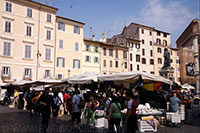
Piazza dei Campo dei Fiori
Campo dei Fiori sits on the unused space that was between Pompey’s Theater and the Tiber River in ancient Rome. Because the river was prone to flooding, the area was undeveloped for many centuries.
It wasn’t until the 15th century that the piazza began to take shape. The first building that appeared there was a church known as Santa Brigida a Campo dei Fiori, which now faces Piazza Farnese, part of the old Campo dei Fiori. In 1456, as part of a city improvement
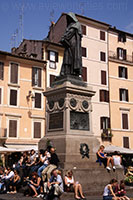
Giordani Bruno
project, the area was paved. The project was initiated because several important buildings had already been constructed in the area, including the Orsini palace and the Palazzo della Cancelleria.
The architecture was never really formalized for Campo dei Fiori as it was for many public squares in Rome and throughout Europe, so the visitor won’t see a lot of continuity in the buildings that surround the square. Instead, the square has always remained a focus for commercial and street culture though the area around Campo dei Fiori was at one time quite a wealthy neighborhood.
Giordano Bruno Statue
Public executions also took place at Campo dei Fiori. One of the more well-known was that of Italian philosopher Giordano Bruno, who in the year 1600 was burned at the stake by the Roman Inquisition because the ideas he spoke of were “dangerous”.
In return, nearly 300 years later, sculptor and philosopher Ettore Ferrari
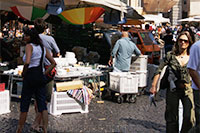
The piazza's market
designed a statue of Bruno and placed it in the piazza, facing the Vatican as if in defiance of all it stands for. Bruno is now considered an advocate and martyr of the right to free speech.
Campo dei Fiori Today
Some things haven’t changed a lot around this busy public piazza. Since 1869, a vegetable and fish market is held here every morning. The former La Terrina, which used to serve as a watering place for cattle, now holds fresh flowers, the only indication that a meadow was once located here.
At night, Campo dei Fiori is a popular gathering place for young adults, both locals and visitors, who travel here to enjoy the cafes and nightspots that surround the piazza.
Castel Sant'Angelo
Castel Sant'Angelo, an imposing building on the right bank of the Tiber river has had a turbulent history, even by Rome's standards.
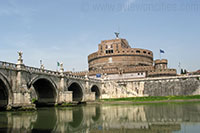
Castel Sant'Angelo
During its many years of existence, the building functioned first as a mausoleum, then became part of the city wall and later was turned into a fortress before it functioned as a papal residence and finally as a barracks and military prison. It is currently a national museum.
Hadrian's Mausoleum
The Castel Sant'Angelo was originally built by Emperor Hadrian as a mausoleum. Construction started in 123 A.D. and was finished in 139 A.D.,
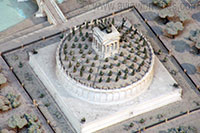
Mausoleum of Hadrian
during the reign of Hadrian's successor, Antoninus Pius.
The building consisted of a square 89m (292ft) wide base on which a cylindrical colonnaded drum with a diameter of 64m was constructed. On the drum was an earthen tumulus topped by a quadriga with Hadrian's statue.
The mausoleum was connected to the city at the other side of the river by a newly constructed bridge, the Pons Aelius. The bridge is now known as the Pont Sant'Angelo. Its many statues were added later
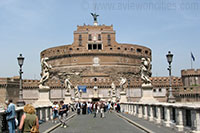
View from Ponte Sant'Angelo
during the Renaissance.
The mausoleum housed the remains of Hadrian and his successors up to Caracalla.
Papal Refuge
Between 270 and 275 A.D., during the construction of the Aurelian walls, Hadrian's mausoleum was fortified and incorporated in the Aurelian Wall around Rome. From that point on the building was slowly turned into a fortress and in 1277 it was acquired by the papacy who used the building as a refuge in case of danger.
A secret corridor,
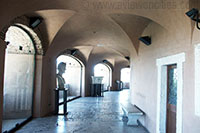
Inside Castel Sant'Angelo
known as the Passetto di Borgo, connects the Castel Sant'Angelo with the Vatican. The corridor was used by Pope Clement VII and his Swiss Guards to take refuge from Charles de Bourbon's army during the sack of Rome in 1527.
Interior
But even in this fortress, the pontiffs made sure they were well housed. The papal apartments in the Castel Sant'Angelo feature beautiful rooms decorated with many frescoes. Below the apartments are several floors which include prisons and even a torture chamber.
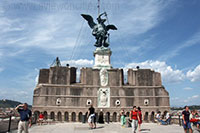
Terrace of Castel Sant'Angelo
A spiraling corridor, part of the original mausoleum, leads to the bottom of the building.
Angel Statue
At the top of the fortress, looking over the panoramic terrace, is a statue of an angel, built by the 18th century Flemish sculptor Pieter Verschaffelt. The bronze statue replaced an earlier, marble version.
The statue depicts the angel who, according to legend, appeared on top of the fortress in the year 590 and miraculously ended the severe plague that had infested the city of Rome. After the event, the building was renamed Castel Sant'Angelo.
Circus Maximus
The Circus Maximus was the largest stadium in ancient Rome. At one point the Circus could seat 250.000 people, one quarter of Rome's population.
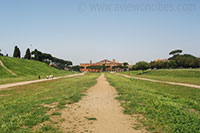
Circus Maximus Today
Early History
Chariot races were one of the Roman's most popular form of entertainment. Romulus, the first of Rome's seven kings, is said to have held chariot races.
The origins of the Circus Maximus go back to the 6th century BC when Tarquinius Priscus, the fifth king of Rome, created a track between the Palatine and Aventine hills. The first permanent starting gates were created in 329 BC. In 174 BC the gates were rebuilt and seven wooden eggs were placed on top of the spina, the central wall in the arena. The eggs were used to count the number of laps; after each lap one egg was removed. In 33 BC seven bronze dolphins were added to the spina for the same purpose.
Wooden Structures
A fire in 31 BC, the first of three, destroyed the wooden structure. It was rebuilt by emperor Augustus who also added an imperial box on the palatine hill. A large obelisk from Heliopolis was added to the spina as a decoration. The obelisk can now be found at the center of the Piazza del Popolo. Another obelisk was added much later, in the 4th century.
A second fire, in AD 64, which started in wooden shops at the bottom around the track started the fire that burned much of Rome during the reign of emperor Nero.

Scale model of the Circus Maximus in Ancient Rome
The Marble Stadium
After yet another fire the Circus was rebuilt by Trajan in AD 103. The Roman empire was at the height of its power and the new Circus Maximus reflected this status. The Circus was now a stone construction, three stories high. The lower part of the cavea (seating area) was built in marble. The arena complex was now more than 600m long and 150m wide (2000x500ft).
Popular Events
The Circus Maximus was occasionally used for events such as processions or gladiator combats, but on most days only chariot races with quadrigaes, pulled by four horses, were held here. The races themselves were wildly popular with people fanatically supporting one of the four factions: red, white, green and blue representing summer, winter, spring and autumn respectively. Bets were laid on one of the factions and supporters of the different factions often clashed, sometimes resulting in deaths among the spectators.
The Last Race
The last race at the Circus Maximus was held in AD 549, almost a millennium after the first races were held at this location. Today only the layout of the original circus can be seen in what is now a large grassland. Most of the original structure has been used as building material for medieval and Renaissance constructions.
EUR
A visit to EUR gives travelers a good look at the visions of the former Italian Fascist leader, Mussolini. EUR was built in the 1930s as a showcase of fascist architecture.
Its History
The area dubbed EUR, short for Esposizione Universale Roma,
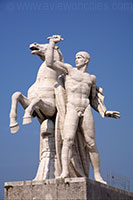
Statue at EUR
was intended to showcase Rome in the World Exhibition of 1942, coinciding with the 20th year of the regime of dictator Mussolini. It was meant to become the monumental gateway of a large city that would stretch all the way to Ostia.
Mussolini and other Fascists had a passion for erecting large buildings, so as they were planning EUR along with architect Marcello Piacentini, the order of the day seemed to be “the bigger, the better.” The result was a number of large, modern buildings that some insist were built to the detriment of Rome’s wonderful early architecture.
Villa Borghese
The Villa Borghese is the largest public park in Rome. It features a lake, temples, fountains, statues and several museums.
The park is located north of the Spanish Steps. Main entrances
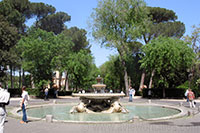
Borghese Park
are at the Piazza del Popolo and the Porta Pinciana at the end of the Via Veneto. The Borghese park is a pleasant refuge from the hectic streets in Rome.
History
The area started as a vineyard in the 16th century. In 1605 cardinal Scipione Borghese, a nephew of pope Paul V, turned the vineyard into a park.
The landscaper Domenico Savino da Montepulciano designed a very formal park with geometric shapes, the first such park in Rome. A villa was built by the architect Flaminio Ponzio after a sketch from the cardinal himself.
The park was later laid out in a more natural way. At the end of the 18th century an artificial lake was
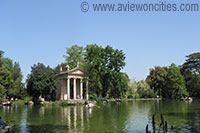
Aesculapius Temple
created in the middle of the park. On the island in the lake, an small Ionic temple was built. It is dedicated to Aesculapius, the God of healing.
A Public Park
In 1903 the city of Rome obtained the Villa Borghese from the Borghese family and the park was opened to the public. The 80 hectare/148 acres large park now featured wide shady lanes, several temples, beautiful fountains and many statues.
Victor Emmanuel Monument
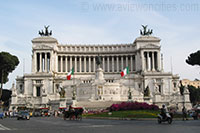
Il Vittoriano
The enormous white marble monument at the Piazza Venezia was built as a tribute to the first King of a united Italy, Victor Emmanuel II.
As King of Sardinia Victor Emmanuel had become a symbol of the movement for a united Italy. After his army joined forces with Garibaldi and defeated the papal army, the Kingdom of Italy was proclaimed in 1861 with Victor Emmanuel as King.
Appian Way
Via Appia Antica (Old Appian Way) was once one of the world's most important roads and the most famous of all the roads that radiated from Rome towards the far ends of the Roman empire.
Building the Road
The Via Appia, originally built in 312 BC, was the brainchild of Appius Claudius Caecus, the then-censor of Rome, who was known for organizing bold public works that helped make life
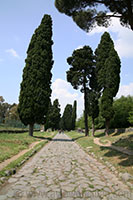
easier for the people of Rome.
Appius Claudius’ most famous project was – by far – this road, which would eventually run all the way from Rome to the port city of Brindisi. The road would travel straight through the Appian Hills and the Pontine Marshes, barely making a turn along its path until it reached the town of Terracina.
The road began as a level dirt surface upon which mortar and small stones were laid. On top of that, gravel was placed, topped with interlocking stones that would provide a flat surface for those traveling along the 560 km long road. Historians say the stones fit together so well that it was nearly impossible to stick a knife between them. Ditches were dug on
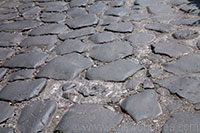
Ancient Roman Pavement
either side of the road and were protected by retaining walls.
A 560 km long road
Via Appia began at the Circus Maximus, passing along the Baths of Caracalla, and later, the Aurelian Wall. Near Rome the road was lined with tombs; the ruins of many can still be seen today.
When the road left the city, it traveled through wealthy suburbs on its way straight through the Appian Mountains and over the former Pontine Marshes. Once it reached Terracina, the Appian Way followed the western coast, eventually ending at Capua, making the
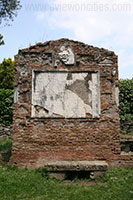
Tomb of Sextus
Pompeius Justus
original road about 210 km long.
This road achieved its goals by helping the Roman army move military supplies where they were needed in a quick manner, resulting in several victories for the army.
Sometime around 295 BC, the road was extended to Benvenutum and then, within the next 5 years, to Venusia and Tarentum. Eventually, the Appian Way made it all the way to the port city of Brindisi on Italy’s southeast coast, 560 km from Rome (about 350 miles).
Monuments Along the Way
Since it was forbidden to bury the dead in the city proper, many were buried along the roads
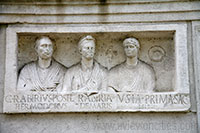
Relief on a tomb
leading out of Rome. Important people built tombs for themselves or for their whole family. Sometimes these tombs were as large as a house. Their shapes varied from a tumulus or a pyramid to a small temple. The Via Appia was lined with such monuments, many of them are still visible today.
The most impressive is the well-preserved tomb of Cecilia Metella - the wife of one of Julius Caesar’s generals, which looks almost like a fortress. Other notable tombs include the tomb of Marcus Servilius, the tomb of
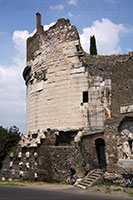
Tomb of Cecilia Metella
Romulus (son of emperor Maxentius), the tomb of Seneca (a Roman philosopher) and the tomb of the family of Sextus Pompeius Justus; The inscription on the tomb tells of the grief of a father burying his young children. There's also an emperor buried along the Via Appia, Gallienus, who was murdered in 268 AD.
Besides the numerous tombs along the road, there are some other monuments that line the Via Appia: the Temple of Hercules; the church Quo Vadis (where Petrus would have met Christ) and the remains of the gothic church of San Nicola.
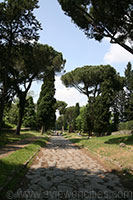
The Villa dei Quintili, with its ancient baths and beautiful friezes and sculptures is located nearby at the Via Appia Nuova.
Underneath
While the Via Appia is lined with monuments and tombs of ancient Roman patrician families, many find what’s under the Appian Way to be more interesting. Below the street are miles of tunnels – known as catacombs – where the early Christians buried their dead and, when necessary, held secret church services. Several of the catacombs are open to the public and on a guided tour led by local priests and monks, visitors can view ancient burial niches and a
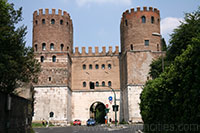
Porta San Sebastiano
handful of remaining examples of early Christian art.
Walking along the Via Appia
Today the Via Appia starts at the Aurelian wall, at the Porta San Sebastiano. The first part of the road is not exactly pedestrian friendly. It leads along the Quo Vadis church, the catacombs of San Callisto and the catacombs of San Sebastiano to the imposing tomb of Cecilia Metella. From here the road is paved with the authentic Roman stones. You can walk for many kilometers passing the remains of numerous historic tombs.
Vatican Museums
What started as just a small collection of sculptures has, over the centuries, turned into a complex of the world’s most magnificent museums featuring one of the finest collections of art on the planet.
History of the Museums
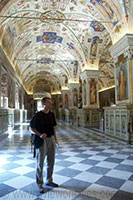
The Vatican Museums were founded under the patronage of two 18th century popes - Clement XIV (1769-1774) and Pius VI (1775-1799) – who were among the first to open collections of art to the general public for viewing, therefore promoting culture among the masses. Appropriately, the first building in the museum complex, the Pio-Clementine Museum, was named after these two pontiffs.
As the decades passed, more popes added to the already impressive collection of diverse artworks owned and displayed by the Vatican. Today, there are 13 museums and collections and an additional 14 Vatican palaces that are included on tours of the Vatican Museum complex. The building complex is worth a visit in itself as all
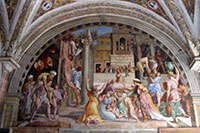
Stanze of Raphael
rooms and hallways are lavishly decorated with marble and frescoes.
The Museums
The many museums that make up the Vatican complex are quite diverse. Nonetheless, each is interesting to explore and which you enjoy most will largely depend on your artistic preferences.
The Gregorian Egyptian Museum was founded in 1839 by Pope Gregory XVI, who had a keen interest in Egypt. Featuring nine rooms, objects d’art in this museum range from third century BC hieroglyphics to third century AD pieces from Mesopotamia and Syria-Palestine.
The Gregorian Etruscan Museum,
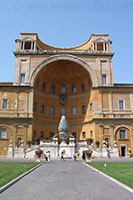
Courtyard
founded by the same Pope, is large and fun to explore. With 23 rooms, this diverse museum includes everything from Tuscan sarcophaguses to Roman jewelry, terra cotta, glass and ivory to wonderful 16th century frescoes by some of Italy’s best.
The Vatican Pinacoteca, one of the newer museums – opened in 1932 – is, technically, a picture gallery. Paintings range in age from the 12th to 19th centuries and include entire rooms devoted to the works of such greats as DaVinci, Bernini, and Raphael. There’s also a unique display of icons from the 15th through 19th centuries.
Founded by Pius XI in 1926, the Ethnological Missionary Museum features objects of a religious nature from four geographical areas – Asia, Oceania, Africa, and America. About 80,000 pieces
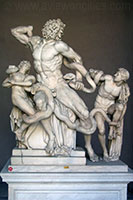
Lacoön
make up the total collection for this particular museum.
Other museums include the Collection of Modern Religious Art, founded by Pope Paul VI in 1973 and featuring 55 rooms; Classical Antiquities Museum (Greek and Roman);the Pio Clementine Museum with the famous Laocoön statue; the Pio Christian Museum (with the Christian and Hebrew Lapidary); Tapestries; Ceramics; Miniature Mosaics; Museo Sacro; Gregorian Profane Museum; and the Vatican Historical Museum, which provides a fascinating look at the long and sometimes turbulent history of the Vatican.
Sistine Chapel and Stanze of Raphael
The Vatican Palaces on the tour include the famous Sistine Chapel, where visitors can enjoy not only Michelangelo’s famous ceiling but also a host of other wonderful works of art, including the artist’s The Last Judgment on the altar wall. (Bring binoculars for a better view.) In addition,
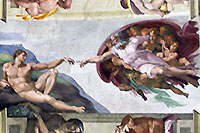
Sistine Chapel
the four rooms known as the Stanze of Raphael, once the residence of Pope Julius II, feature the works of Raphael and others from his school.
Other ornate Vatican Palaces are also featured on the tour, including the Upper Galleries of Tapestries and Maps and residences of several former pontiffs.
Visiting the Vatican Museums
Once you’ve purchased your tickets for admission to the Vatican Museums, you can choose to follow one of four color-coded itineraries that range from 1 ½ hours to more than 5 hours. All itineraries end in the Sistine Chapel. Even with a five-hour tour, it’s impossible to see everything there is to admire, but you’ll get a good overview and hit the most well-known highlights of these magnificent museums.
Vatican City
The world’s smallest country, Vatican City occupies 0.44 sq km (about .2 square miles) and serves as the spiritual center for millions of practicing Roman Catholics worldwide.
History of Vatican City
Usually referred to as a City State and often called “The Holy See”,
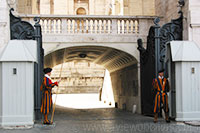
Swiss Guards
Vatican City is home to about 800 residents. None of them are permanent. The population of this tiny area, which surrounds St. Peter’s Basilica, is made up of priests, nuns, guards, high-ranking dignitaries and, of course, the Pope, and is constantly changing.
Vatican City wasn’t always this small. In the mid-19th century, the Papal States covered approximately 17,000 square miles. However, during the next decade and the struggle for Italian unification, the majority of these states officially became a part of the country of Italy.
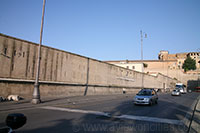
Walls surrounding Vatican City
The Pope’s power was abolished and the papal territory was confined to the Vatican. In 1929, the Treaty of Lateran gave The Holy See autonomy, officially establishing this tiny area that attracts millions of visitors each year. The city state is protected by its own military, the strangely-clad Swiss Guards.
St. Peter's Square
Guests enter Vatican City through expansive St. Peter’s Square. This breathtaking piazza is one place in Rome that no one should miss, regardless of their religious persuasion. The square was
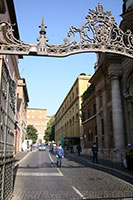
Inside the City State
laid out by Bernini during the pontificates of Alexander VII and of Clement IX (1657-1667). Visitors to this magnificent square (which is actually a circle) are surrounded by two huge colonnades, with 284 Doric columns arranged in 4 rows, atop which stand 140 saints.
In the center of the square, you’ll find an 85-foot-tall Egyptian obelisk, brought to Rome by Caligula in 38 AD from Heliopolis, located on the Nile Delta. Fountains are situated on either side of the obelisk. The one sitting on the right was placed in this location but Bernini and was made by Carlo Maderno. The other was created by Carlo Fontana.
Thousands of guests gather in the square to hear blessings from the
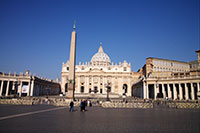
St. Peter's Square
Pope or to participate in masses being celebrated by the Roman Catholic’s most revered Holy Father, especially on religious holidays such as Christmas and Easter.
St. Peter's Basilica
St. Peter’s Basilica, the crowning glory of Vatican City, is the most important church in the world. The cornerstone of this church was laid more than 500 years ago, in 1506.
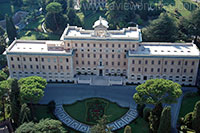
Governorate Palace
The magnificent altars and monuments inside the church are too numerous to mention, but even those who aren’t art aficionados will be wowed by what they’ll find inside this amazing basilica, including more works by Italian sculptor, painter, and architect, Gian Lorenzo Bernini and also Michelangelo’s Pieta. The dome of St. Peter’s is accessed from an elevator to the roof. Once you’ve reached the top of the elevator, 323 additional steps take you to the best view of Rome from anywhere in the city. The papal apartments are also here as are the expansive Vatican Museums, home to the largest and most valuable art collection in the world.
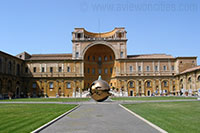
Courtyard at the Vatican Museum
A tour of the museums is a must for any visitor.
Finding Your Way Around
Vatican City is an amazing place, so you’ll want to be sure you don’t miss a thing. The Vatican has its own tourist office on the left side of the piazza which is a good place to begin your visit. Here you can book tours of Vatican City's gardens and purchase maps and other guide books for self-guided tours of the square, basilica, and museums.
By the way, rumor has it that the Vatican’s postal system is better than that of the city of Rome, so be sure to mail your postcards there!
Trajan's Markets
Rome’s ancient “shopping center” known as Trajan’s Markets is remarkably well preserved and
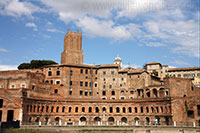
Trajan's Market
worth a visit.
The complex
Trajan’s Market, a large complex of warehouses, shops and offices where the Romans would gather to purchase goods and conduct business, was built between 107 and 110 AD by the Emperor Trajan’s favorite architect, Apollodorus of Damascus. Apollodorus was integral in designing the famous Forum which bears the emperor’s name and borders the market.
Trajan’s Market was set into the side of Quirinal Hill and served to complete the forum. Apollodorus built a large monumental facade consisting of a half exedra bordered by a row of columns. At both ends were smaller exedras that
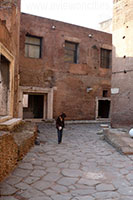
were covered by a halve dome.
Trajan's Column

Trajan's column was erected A.D. 106 to 113 in honor of emperor Trajan. It was located at the then just completed Trajan forum and surrounded by buildings. The column commemorates his victories in Dacia (now Romania).
The Trajan column including its base is 42m high (138ft). This was exactly the height of the hill that stood at this site. It had been leveled to create an open space for the construction of Trajan's Forum.
Band of Reliefs
A band of beautifully carved reliefs winds around the column. The band is more than 180m/600ft long. Its width varies from 60cm/2ft at the bottom to 120cm/4ft at the top. There are more than 2000 carved figures depicting the story of Trajan's Dacian wars between 101-102 and 105-106 A.D. It starts with soldiers preparing for the war and ends with the Dacians being ousted from their homeland. The column consists of 29
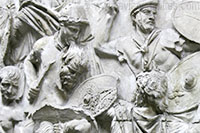
Detail of the column's relief
pieces of white marble, the largest one weighing up 77 tons. The reliefs were not always in plain white: originally they were gilded and, like many roman monuments, brightly colored.
Statue
Initially, a statue of an eagle topped the column, but after Trajan's death it was replaced by a 20ft tall statue of the emperor himself. His ashes and later those of his wife Plotina were placed in the base of the column. In 1587 the statue
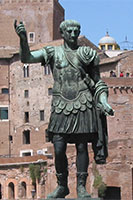
Emperor Trajan
was replaced again, this time by one of St. Peter.
Saved from Demolition
Legend has it that the column was saved from demolition thanks to Pope Gregory the Great (590-604). He was so moved by a relief depicting Trajan helping the mother of a dead soldier, that he begged God to save Trajan's pagan soul from hell. God then told the pope that Trajan's soul had been saved. The legend also tells Trajan's tongue was still intact when his ashes were excavated. The tongue told about his rescue from hell. The area around the column was then declared sacred, thus saving the column from demolition.
Location
The column is located at Trajan's forum - part of the Imperial Forums - at the Via dei Fori Imperiali, right next to the Piazza Venezia.
Tiber Island
Located on the southern bend of the Tiber River as it makes its way through the city of Rome, Tiber Island is a small boat-shaped isle that has been associated with healing since the era of the Roman Republic.
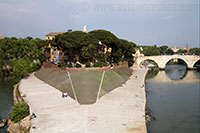
Tiber Island today
The Island
The Tiber Island measures about 270 meters (885 feet) in length and is 67 meters (220 feet) wide at its widest point. It is connected to the main land by two bridges: the Ponte Fabricio, which travels from the northeast part of the island to the Campus Martius; and the Ponte Cestio, which connects the island to the Trastevere on the right bank. These same two bridges have linked Tiber Island to the rest of Rome since antiquity,
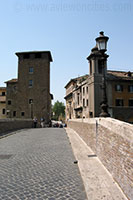
Ponte Fabricio
though only a few original parts of the Ponte Cestio remain.
The creation of the Island
Legend has it that Tiber Island was formed when Roman citizens expulsed the last of the Tarquin Kings (Tarquinius Superbus or Tarquin the Proud). In anger the insurgents threw wheat sheaves they had stolen from the king into the river. Dirt and silt accumulated around the wheat and soon formed an island. In reality however the island was formed long before the Etruscans ruled over Rome, probably by natural means due to the river becoming wider and its current less strong.
Boat-shaped
The island was important in the early Roman period since the it made crossing the river much easier.
A travertine embankment wall built around the
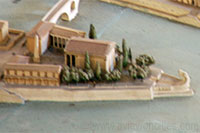
The island's 'prow' and the Temple of Aesculapius
island in the shape of a prow and stern at each end gave it the appearance of a boat.
That image was enforced even more when an obelisk was placed at the center of the island, acting as the ship's mast.
Temple of Aesculapius
In 293 BC, when Rome was hit by a terrible plague, Romans decided to build a temple in honor of Aesculapius, god of medicine and healing. Legend says that a snake taken from the original temple of Aesculapius slithered from onboard a ship and chose the island as the location
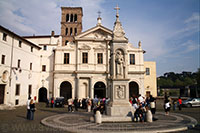
San Bortolomeo Church
for the temple, but it is more likely that the island was chosen because it was separate from the mainland and could not be reached by the plague.
Following the completion of the temple to Aesculapius in 291 BC, other shrines were constructed on Tiber Island as well, including one to Tiberinus the river god and another to Bellona, a war goddess.
In 998 AD, a new basilica, San Bartolomeo, was built over the ruins of the original Aesculapius temple and, in keeping with the island’s theme of healing, a hospital was built there in 1584 and still stands on the western part of the island.
The Theater of Marcellus
The Theater of Marcellus was built by Emperor Augustus in 13 BC. It was the largest theater in ancient Rome.
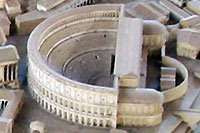
Theater of Marcellus in Ancient Rome
After Julius Caesar defeated Pompey in the struggle for control over Rome, he wanted to build a theater rivaling the Pompey theater which Caesar's his bitter enemy had built in 55 BC. When Caesar was killed in 44 BC the project had only just started.
In 22 BC Augustus, known as the emperor who turned Rome from a city of brick into a city of marble, restarted the project.
Santa Maria Maggiore
The Basilica of Santa Maria Maggiore is the largest church in Rome dedicated to the Virgin Mary.
Basilica Facts
The Papal Basilica of Santa Maria Maggiore (St. Mary Major) is one of four papal basilicas in Rome.
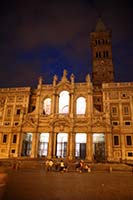
The church at night
The name of the church (“major”) indicates that is indeed an important place of worship within the Roman Catholic Church. It is sometimes called the Liberian Basilica because of its connection with pope Liberius.
Santa Maria Maggiore has retained its original core even though many renovation and addition projects have been undertaken since the church was damaged by an earthquake in the mid-14th century.
Legend of the Snow
Legend has it that in the year 356, Maria appeared in a dream to pope Liberius and ordered him to build a church at a site where it would snow. When it snowed a couple of years later on the Esquiline Hill - apparently in the middle of summer - Liberius decided to build a basilica on top of the hill. The present building, however, dates from the time of pope Sixtus III, who reigned from 432 to 440. Its design very closely follows that of an imperial basilica, though it is not one.
Imperial Forums
The heart of the ancient Roman Empire, the Imperial Forums were a gathering place and a center for religion and politics.

Overview
The Imperial Forums, not to be confused with the older Roman Forum, are a series of public squares that were constructed between 46 BC and 113 AD.
For many decades, they were the center of city life and important figures gathered here to discuss the economy or expound upon their beliefs about politics or any other hot subjects of the era.
Forum of Caesar
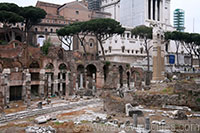
Forum of Caesar
The first of the Imperial Forums to be built, the Forum of Caesar was actually an extension to the Roman Forum.
Meant to celebrate Caesar’s great power, this forum also contained a temple to the goddess Venus, as Caesar’s family believed they were directly descended from her. A statue of Caesar himself, riding a horse, was placed in front of the temple.
Forum of Augustus
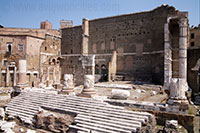
Temple of Mars, Forum of Augustus
Inaugurated in 2 BC, the Forum of Augustus is said to have been constructed to avenge the death of Caesar, thus, Augustus dedicated the forum's temple to Mars the Avenger.
It is situated perpendicular to Caesar’s Forum and is believed to have been used as a court of law. It was rectangular in shape with very high walls. Four exedras (semicircular recesses crowned by a half-dome) are believed to have graced the façade of the building. Most of the decorations pertained to the god Mars.
Forum of Nerva (aka The Transitional Forum)
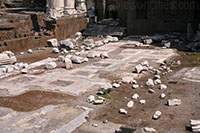
Forum of Nerva
Built by Domitian, this forum served to connect the other two forums together as well as the Temple of Peace – not an official forum but built to celebrate the conquest of Jerusalem.
This forum was supposed to be dedicated to Minerva – protector of the emperor – but because it was inaugurated after Domitian’s assassination, his successor – whose name was Nerva – dedicated it to himself. Because of where it was built, it is rather narrow in shape and its large entrance tended to serve as an access way to all the other forums.
Forum of Trajan
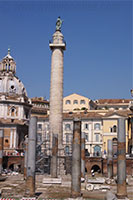
Trajan's Forum
The largest and greatest of the Imperial Forums, Trajan’s Forum was built to honor the conquest of Dacia in southeastern Europe (now Romania).
Much excavation had to be done to complete this forum, which consisted of several parts: a public square, a large temple (the Temple of Divius Traianus), two libraries and the immense Basilica Ulpia, which measured about 60x170 meter (197x558 ft) in size. For some time this particular civic building moved the center of political life from the Roman Forum to the Imperial Forums. Many of its marble columns still stand today.
The 42 meter (138ft) tall Trajan’s Column, located between the Basilica Ulpia and the Temple of Trajan indicated the exact height of the hill that was excavated for the construction of the forum. Adjacent to the large forum was Trajan's Market, a semi-circular warehouse complex annex stores.
Janiculum
Also known as Gianicolo in Italian, Janiculum Hill is often considered the “Eighth Hill of Rome”, referring to the seven hills around which Ancient Rome was built.
The History of the Hill
Janiculum, the second highest hill in the contemporary city of Rome and separate from the
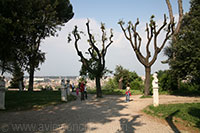
famed Seven Hills of Rome, was believed to be the center for the cult of the god Janus.
Because of its stunning location overlooking the city, it is said that the cult’s priests would stand atop the hill and look for auspices, or signs from the gods.
The Aurelian Wall made its may up the Janiculum Hill in order to include inside the walls of the city the water mills that were used to grind corn and make bread. The ancient water mills were used until around the end of ninth century AD.
Centuries later, in the 1800s, Janiculum Hill was
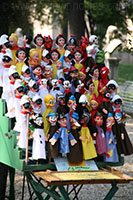
Puppets
the site of a memorable battle. In 1849, Giuseppe Garibaldi fought against French troops attacking Rome. Even though the French well outnumbered Garibaldi's troops, they were able to resist the French for several weeks. This event prompted the building of several monuments on the hill that pay homage to Garibaldi and his comrades.
Attractions
Locals often come here for a walk as the park provides a welcome retrieve from the hectic streets in Rome. There are also some activities popular with children, one of them an authentic puppet theater.
Many tourists head to the top of Janiculum Hill just for the view that it provides. However, there are other things to see atop this mound.
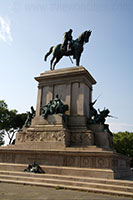
Garibaldi Monument
Garibaldi Monuments
The largest monument on the Janiculum is the Garibaldi Monument, an enormous equestrian statue of Giuseppe Garibaldi, honoring the Italian patriot's heroics on this hill in 1849. The statue, located at the center of a small piazza, was built in 1895 after a design by Emilio Gallori.
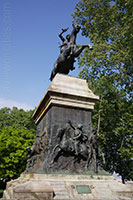
Anita Garibaldi Monument
Four sculptures on the large pedestal depict both battle and allegorical scenes.
Giuseppe Garibaldi wife Anita, who fought alongside him is also honored with an equestrian statue. Created in 1932 by Mario Rutelli it depicts Anita Garibaldi with a pistol in her right hand holding a baby in her other hand. The two Garibaldi statues are a mere 200 meters apart, connected via the Viale aldo Fabrizi.
Independence War Memorial
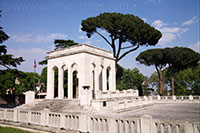
Independence War Memorial
And there's another monument on the Janiculum honoring Italian Patriots: a formal arched memorial with the inscription 'Roma o Morte' (Rome or death) honors the patriots who died in the Italian Independence wars between 1848 and 1870.
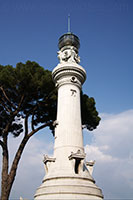
Manfredi Lighthouse
Manfredi Lighthouse
A totally different sight on the hilltop is the Manfredi lighthouse. Built in 1911, it was a gift from Italian immigrants in Argentina to Rome.
San Pietro in Montorio and Tempietto
Visitors can also explore the Church of San Pietro in Montorio at the bottom of the hill. The church is believed to be built at the site of the crucifixion of St. Peter. A small shrine by Donato Bramante marks the spot where Peter supposedly died.
Not far from the church is another building that claims to be on the exact site of Petrus's crucifixion: the Tempietto (small temple). Built by Bramante in 1502 the round temple is architecturally
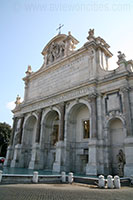
Fontana dell'Acqua Paolo
significant since it is considered the first renaissance building in Rome.
Fontana dell'Acqua Paola
The Fontana dell'Acqua Paolo, a monumental baroque fountain built in the early 17th century by pope Paul V, can also be found on Janiculum Hill, at the bottom of the park. The fountain was built here to celebrate the reopening of an old roman aqueduct, originally created in 109 AD by emperor Trajan. The fountain was named after the pope (Paolo is Italian for Paul).
Pantheon
Built more than 1800 years ago, the magnificent Pantheon building still stands as a reminder of the great Roman empire.
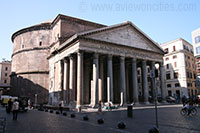
Pantheon
The building's dome, more than 43 meters high is most impressive. It was the largest dome in the world until 1436 when the Florence Cathedral was constructed.
At the top of the dome is a large opening, the oculus, which was the only source of light.
The front portico has three rows of 8 columns, each one with a diameter of 1.5m. A huge bronze door gives access to the cylindrical building. Its
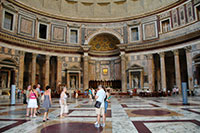
Interior
diameter equals the interior height of 43,3m.
Interior
Originally a temple for all pagan gods, the temple was converted into a church in 609. The Pantheon now contains the tombs of the famous artist Raphael and of several Italian Kings. Its ecclasiastic interior design contrast with the temple's structural design, but the marble floor - which features a design consisting of a series of geometric patterns - is still the ancient Roman original.
Earlier Temples
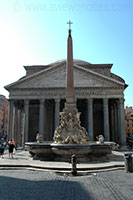
Before the current Pantheon was built, two other buildings occupied the same site. The first one, a traditional rectilinear, T-shaped structure was built in 27 BC by the emperor Marcus Agrippa, son-in-law of the emperor Augustus. The temple was dedicated to the gods Mars and Venus. It burned down in AD 80 but was rebuilt by emperor Domitian. In AD 110 the building was struck by lightning and burned down again. In AD 118 emperor Hadrian commissioned for the Pantheon to be rebuilt but with a totally different, circular design. This time the Pantheon building would last much longer.
The Dome
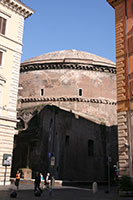
View from Piazza della Minerva
The most important problem the Romans faced during the construction of the Pantheon was the massive weight of the large dome. In order to support it without proper reinforcement as it is common today, the thickness of the walls gradually decreased as the height increased. The Romans also used a different type of concrete for the dome as for the walls. At the base very thick (6m, 20ft) walls were constructed. At the top of the dome, a lighter type of concrete was used and near the oculus it is only 7.5 ft or 2.3 m thick. The use of coffers in the ceiling and the opening at the top also helped reduce the weight of the dome.
The Columns
The huge, 60 tons weighing columns used for the portico were quarried in Egypt. They were transported all the way to Rome using barges and vessels.
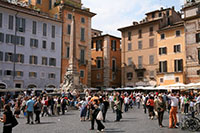
Piazza della Rotonda
The columns support a pediment with an inscription attributing the Pantheon to Marcus Agrippa even though it was built by Hadrian.
Piazza della Rotonda
The Pantheon borders the Piazza della Rotonda, a rectangular square with a central fountain and obelisk. The often crowded square is situated in the historic center of Rome, not far from the Piazza Navone, one of Rome's most beautiful squares.
Pyramid of Caius Cestius
This 36 meter (118ft) tall pyramid was built by praetor Caius Cestius as his tomb.
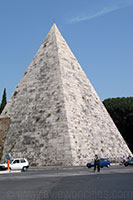
Pyramid of Caius Cestius
A Fashionable Tomb
Caius Cestius, a rich praetor (an elected magistrate) and member of a group of priests responsible for sacred banquets died in 12 BC. He had built himself a tomb modeled on Egyptian pyramids.
Anything Egyptian had become fashionable after Rome had conquered Egypt in 30 BC, hence the uncommon choice for a pyramidical tomb.
The Pyramid
The pyramid, which was constructed in a mere 330 days, is more than 36 meter high and 29,5 meter wide (118x97ft). It was built of concrete and brick on a travertine foundation and covered with carrara marble blocks. Thanks to the use of concrete it was possible to build a pyramid with a sharper angle - and relatively taller - than those in Egypt.
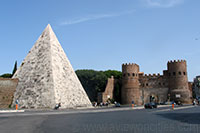
The pyramid and Porta San Paolo
On the east and west sides are inscriptions with the names and titles Caius Cestius. A corridor at the northern side led to the burial chamber. The walls of the rectangular chamber, which measured 6 by 4 meter (20x13ft), were decorated sumptuously with frescoes and panels framing female figures.
The pyramid was originally surrounded by four columns and flanked by two bronze figures, now in the Musei Capitolini at the Capitoline Hill.
Aurelian Wall
While the interior is badly preserved the exterior has survived relatively well thanks to the incorporation of the pyramid
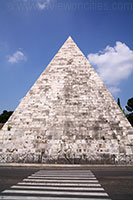
into the Aurelian wall in 275 BC. Its marble casing was restored in the XIIth century.
Rome's wealth
Only three Egyptian pyramids - the main pyramids of Gizeh - are taller than this Roman imitation. It tells us something about the wealth of Rome during the reign of emperor Augustus, when a single citizen - albeit a rich one - was able to build a pyramid worthy of Pharaohs.
Location
The Pyramid of Caius Cestius can be found at the southern edge of ancient rome, near the Porta San Paolo, part of the Aurelian Wall. The subway station 'Pyramide' is right across the square.
Transportations
Due to its location in the centre of the Italian peninsula, Rome is a principal railway node for central Italy. Rome's main train station, Termini, is one of the biggest train stations in Europe and the most heavily-used in Italy, with around 400 thousand travellers passing through every day. The second-largest station in the city, Roma Tiburtina, is currently being redeveloped as a high-speed rail terminus.
Rome is served by three airports. The intercontinental Leonardo Da Vinci International Airport is Italy's chief airport and is commonly known as "Fiumicino Airport", as it is located within the nearby Comune of Fiumicino, south-west of Rome. The older Rome Ciampino Airport is a joint civilian and military airport. It is commonly referred to as "Ciampino Airport", as it is located beside Ciampino, south-east of Rome. A third airport, the Roma-Urbe Airport, is a small, low-traffic airport located about 6 km north of the city centre, which handles most helicopter and private flights.
The city suffers from traffic problems largely due to this radial street pattern, making it difficult for Romans to move easily from the vicinity of one of the radial roads to another without going into the historic centre or using the ring-road. These problems are not helped by the limited size of Rome's metro system when compared to other cities of similar size. In addition, Rome has only 21 taxis for every 10,000 inhabitants, far below other major European cities. Chronic congestion caused by cars during the 1970s and 1980s led to restrictions being placed on vehicle access to the inner city-centre during the hours of daylight. Areas where these restriction apply are known as Limited Traffic Zones (Zona a Traffico Limitato (ZTL) in Italian). More recently, heavy night-time traffic in Trastevere and San Lorenzo has led to the creation of night-time ZTLs in those districts, and there are also plans to create another night-time ZTL in Testaccio
A 2-line metro system called the Metropolitana operates in Rome. Construction on the first branch started in the 1930s. The line had been planned to quickly connect the main train station with the newly-planned E42 area in the southern suburbs, where the 1942 World Fair was supposed to be held. The event never took place because of war. The area was later partly redesigned and renamed EUR (Esposizione Universale di Roma: Rome Universal Exhibition) in the 1950s to serve as a modern business district. The line was finally opened in 1955, and it is now part of the B Line.
The A line opened in 1980 from Ottaviano to Anagnina stations, later extended in stages (1999 – 2000) to Battistini. In the 1990s, an extension of the B line was opened from Termini to Rebibbia. This underground network is generally reliable (although it may become very congested at peak times and during events, especially the A line) as it is relatively short. As of 2005, its total length is 38 km (24 mi).
The two existing lines, A and B, intersect at Roma Termini station. A new branch of the B line (B1) is under construction with an estimated cost of €500 million. It is scheduled to open in 2010. B1 will connect to line B at Piazza Bologna and will have four stations over a distance of 3.9 km (2 mi). A third line, line C, is under construction with an estimated cost of €3 billion and will have 30 stations over a distance of 25.5 km (16 mi). It will partly replace the existing Rail Road line, Termini-Pantano. It will feature full automated, driverless trains. The first section is due to open in 2011 and the final sections in 2015, but archaeological findings often delay underground construction work.
A fourth line, line, is also planned. It will have 22 stations over a distance of 20 km (12 mi). The first section is projected to open in 2015 and the final sections before 2035.
Above-ground public transport in Rome is made up of a bus and tram network. This network is run by Trambus S.p.A. under the auspices of ATAC S.p.A. (which originally stood for the Bus and Tram Agency of the Commune, Azienda Tranvie ed Autobus del Comune in Italian). The bus network has in excess of 350 bus lines and over 8 thousand bus stops, whereas the more-limited tram system has 39 km of track and 192 stops. There is also one trolleybus line, opened in 2005, and additional trolleybus lines are planned.
No comments:
Post a Comment